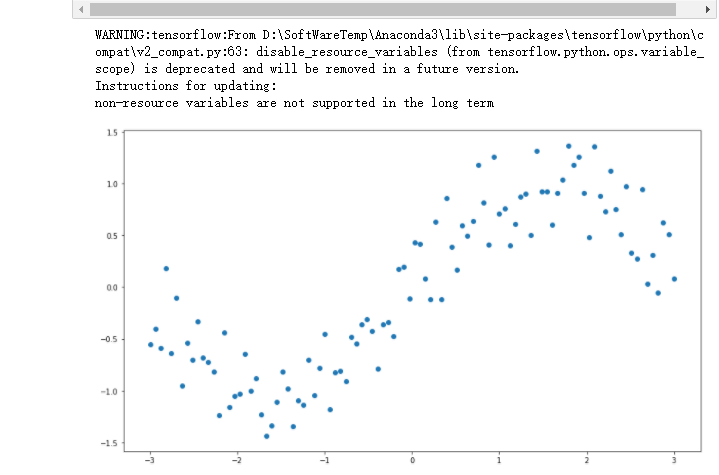1.数据准备
%matplotlib inline import numpy as np #import tensorflow as tf# #引入tensorflow 并保证 placeholder 可以使用 import tensorflow.compat.v1 as tf tf.disable_v2_behavior() import matplotlib.pyplot as plt ## 设置figure_size尺寸 plt.rcParams["figure.figsize"] = (14,8) n_observations = 100 #创建等差数列 -3到 3 100个 xs = np.linspace(-3, 3, n_observations) #从一个均匀分布[low,high)中随机采样,注意定义域是左闭右开 numpy.random.uniform(low,high,size) ys = np.sin(xs) + np.random.uniform(-0.5, 0.5, n_observations) #绘制散点图 (x,y)平面的位置 plt.scatter(xs, ys) plt.show()

2.准备好placeholder
# 定义参数的数据类型 数据形状(一般为一维)名称 X = tf.placeholder(tf.float32, name='X') Y = tf.placeholder(tf.float32, name='Y') # 设置参数为全局变量 global X global Y global W
3.初始化参数/权重
# tf.Variable(initializer,name) 初始化参数 和 自定义的变量名称 #tf.random_normal()函数用于从“服从指定正态分布的序列”中随机取出指定个数的值 W = tf.Variable(tf.random.normal([1]), name='weight') b = tf.Variable(tf.random.normal([1]), name='bias')
4.计算预测结果
#预测值 tf.multiply()两个矩阵中对应元素各自相乘 tf.add() 将参数相加 Y_pred = tf.add(tf.multiply(X, W), b)
5.计算损失函数值
#损失函数 对a里的每一个元素求平方 loss = tf.square(Y - Y_pred, name='loss')
6.初始化optimizer
#学习率 learning_rate = 0.01 #optimizer = tf.train.GradientDescentOptimizer(learning_rate).minimize(loss) # 实现梯度下降和会话流程 optimizer = tf.train.GradientDescentOptimizer(learning_rate).minimize(loss)
7.指定迭代次数,并在session里执行graph
n_samples = xs.shape[0] with tf.Session() as sess: # 记得初始化所有变量 sess.run(tf.global_variables_initializer()) writer = tf.summary.FileWriter('./graphs/linear_reg', sess.graph) # 训练模型 for i in range(50): total_loss = 0 for x, y in zip(xs, ys): # 通过feed_dic把数据灌进去 _, l = sess.run([optimizer, loss], feed_dict={X: x, Y:y}) total_loss += l if i%5 ==0: print('Epoch {0}: {1}'.format(i, total_loss/n_samples)) # 关闭writer writer.close() # 取出w和b的值 W, b = sess.run([W, b])

# 输出W b 的值 print(W,b) print("W:"+str(W[0])) print("b:"+str(b[0]))

#设置散点图的图例 plt.plot(xs, ys, 'bo', label='Real data') plt.plot(xs, xs * W + b, 'r', label='Predicted data') #给图像加上图例 plt.legend() plt.show()
